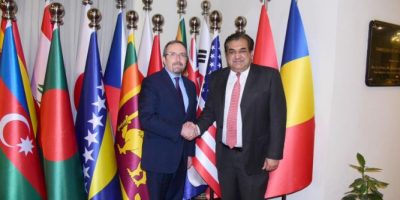90-hour conflict with Pakistan ended in a stalemate and that’s a defeat for India

Just 90 hours proved enough to bring about a radical shift in how strategic competitive conflict between India and Pakistan would play out in the future. Unlike the tactical ‘one-off’ operation in Uri, which was Prime Minister Narendra Modi’s first attempt to alter the status quo but produced no strategic results, Balakot was different.
Post-Pulwama, India’s immediate political aim was to set a new normal – to strike preemptively against terrorism-related targets anywhere in Pakistan – for its response to Pakistan’s proxy war driven by terrorism under the cover of an irrational nuclear strategy, and shape the international opinion against its use of terrorism as a state policy. Its military aim was to demonstrate its capability for the same, neutralise Pakistan’s response with heavy costs and be prepared for escalation.
Pakistan’s immediate political strategy was to preserve its sovereignty, retain its international relevance and deter India from exploiting the new normal. Its military aim was to neutralise India’s preemptive strikes with heavy costs, demonstrate its capability for a quid pro quo response, and be prepared for escalation.
Overall, the 90-hour conflict, from 26 February to 1 March, ended in a stalemate, with both sides partially achieving their political and military aims. This should be a cause of concern for India as it raises questions about lack of a comprehensive national security and military strategy.
Politically, India succeeded in shaping international opinion, to some extent even China’s, against Pakistan’s use of terrorism as a state policy.
Diplomatically, India managed to isolate Pakistan post-Pulwama and during the 90-hour crisis. Backdoor diplomacy, led by the US, diffused the situation and prevailed upon Pakistan to release IAF Wing Commander Abhinandan Varthaman.
International community has put Pakistan on notice and has forced it to initiate action against the ‘proscribed’ terrorist organisations. Pakistan’s track record in this regard does not inspire confidence. One can only hope that Imran Khan’s ‘Naya Pakistan’ walks the talk.
However, given Pakistan’s geo-strategic location, its ‘alliance’ with China and Islamic countries, and its indispensability vis-a-vis American exit from Afghanistan, India’s diplomatic gains may only be temporary.
Militarily, the conflict ended in a stalemate due the quid pro quo aerial strikes by the Pakistan Air Force and the ‘drawn’ aerial engagement, thus blunting the psychological fear regarding India’s conventional superiority.
The reasons are not hard to fathom. Rather than promptly implementing contingency plans based on a long-term formal strategy, Indian response strategy has been ad hoc and event-driven. We neither have a comprehensive strategy nor have we created the overwhelming technological and military edge, which is a prerequisite for the success of this strategy.
Prime Minister Narendra Modi, carried away by political rhetoric, inadvertently admitted this inadequacy. At the India Today conclave on 2 March, he said: “India is feeling the absence of Rafale. The entire country is saying in one voice today, if we had Rafale probably the result would have been different…”. He only stated the obvious.
Why just Rafale, Prime Minister, even modern rifles would make a difference. You laid the foundation stone for a rifle manufacturing unit on 3 March in Amethi at the fag end of your tenure.
Similarly, a comprehensive National Security Strategy and reforms in higher defence management, armed forces’ structure/organisations, and modernisation have been pending. There has been no forward movement in this regard for the last 20 years, which includes 10 years each of the Congress and the BJP rule.
Stalemate is a defeat
In the last few days, Pakistan stole a march over us in perception management, which was directed at the domestic and the international audience, including India’s. In today’s transparent world, one cannot solely rely on cryptic statements by the government without credible evidence. Once politicians start managing perception through political rhetoric at rallies/public functions, sooner than later they score self-goals as has been evident from the contradictory statements of the BJP leadership.
Despite politically driven neo-nationalism having dominated the public debates for the last five years, our threshold for pain is very low and certainly much lower than Pakistan’s. The plight of the captured air warrior became a national obsession, which in turn influenced political and military decision-making. In my view, raising the ante with more air strikes would have put us in a better strategic situation.
War-mongering in the last few weeks must not let us forget that there is a far more cost-effective option available – winning the hearts and minds of the people of Jammu and Kashmir. Forcing ‘compellence’ on Pakistan is going to be a long haul. If present diplomatic efforts fail, India may have to exploit the new normal and go up the escalatory ladder, right up to a limited war. And for that, a national security strategy and other highlighted reforms aimed at building an overwhelming technological-military edge are a prerequisite. Else, we will always be militarily stalemated and a stalemate is a defeat for India.
Lt Gen H S Panag PVSM, AVSM (R) served in the Indian Army for 40 years. He was GOC in C Northern Command and Central Command. Post retirement, he was Member of Armed Forces Tribunal.
COURTESY THE PRINT
Related News

Chairman Bilawal Affirms PPP’s Dedication to Labor Empowerment and Social Justice
DNA KARACHI/ISLAMABAD/LAHORE, April 30: Chairman Pakistan People’s Party (PPP) Bilawal Bhutto Zardari, reaffirmed the foundingRead More

US, Pakistan discuss trade, investment, and regional security
ISLAMABAD, APR 30 /DNA/ – A US State Department delegation led by Acting Under SecretaryRead More


Comments are Closed